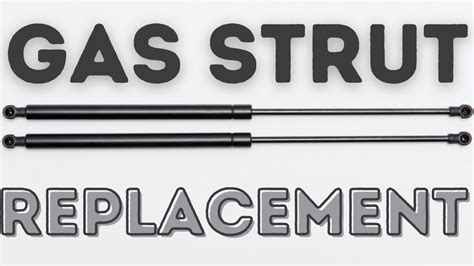Gas Strut Replacement Made Easy: Start with Accurate Measurement
Replacing a gas strut might seem daunting, but with the right approach, it's a manageable DIY task. The key to a successful replacement lies in accurate measurement. Getting this step right ensures you purchase the correct replacement strut and prevents potential issues during installation. This guide will walk you through the process, answering common questions and providing tips for a smooth, efficient repair.
Why Accurate Measurement is Crucial
Before even thinking about removing your old gas strut, accurate measurement is paramount. Using the wrong strut can lead to several problems:
- Incorrect Force: A strut with insufficient force won't lift or support the weight it's designed for, leaving your application malfunctioning. Conversely, a strut with excessive force could be dangerous, potentially causing damage or injury.
- Improper Extension Length: The strut's extended and compressed lengths must match your application's requirements. A mismatch will prevent proper operation and may cause strain on other components.
- Wastage and Expense: Ordering the wrong strut means returning it and ordering another, leading to wasted time and money.
What to Measure: A Step-by-Step Guide
Measuring your gas strut involves several key dimensions. You'll need a reliable measuring tape and possibly a helper. Here's the breakdown:
-
Extended Length: This is the measurement from the center of the eyelet (the mounting point) at one end to the center of the eyelet at the other end, when the strut is fully extended. Ensure the strut is fully extended before taking this measurement.
-
Compressed Length: This is the measurement from the center of one eyelet to the center of the other when the strut is fully compressed. Be careful when compressing the strut, as it can exert considerable force.
-
Stroke Length: This is the difference between the extended and compressed lengths. It represents the distance the strut travels from fully extended to fully compressed. Calculate this by subtracting the compressed length from the extended length.
-
Eyelet Diameter and Type: Note the diameter of each eyelet (the mounting point) and the type of eyelet (e.g., ball stud, clevis pin). These details are crucial for ensuring a proper fit.
-
Mounting Hole Centers: In some cases, you might need to measure the distance between the mounting holes on the components where the strut attaches, not just the eyelet centers. This ensures correct alignment during installation.
-
Shaft Diameter: While less critical for replacement, knowing the shaft diameter can be useful for cross-referencing with manufacturer specifications.
Always take multiple measurements for each dimension to ensure accuracy and to account for any slight variations.
What if I Don't Have the Original Strut?
If you don't have the original strut to measure, you can try to find a similar strut by visual inspection and using the measurements from the application itself. Look at the mounting points and the overall range of motion to get a rough idea of the required strut dimensions.
How to Use Your Measurements to Find a Replacement
Once you have your measurements, you can use them to search for a replacement strut online or at a hardware store. Most reputable suppliers will have detailed specifications for their gas struts, allowing you to match your measurements to find the perfect fit. Be sure to double-check all dimensions before making a purchase.
Beyond Measurements: Other Important Considerations
While accurate measurements are the cornerstone of successful gas strut replacement, other factors play a role:
- Gas Pressure: While you usually don't need to measure the gas pressure directly, the correct pressure is implied by the other measurements. Using a strut with incorrect pressure can lead to failures.
- Material Compatibility: Make sure the replacement strut is made from materials compatible with your application and environment.
- Mounting Hardware: Ensure you have the correct mounting hardware (bolts, nuts, washers) to securely attach the new strut.
By meticulously measuring your old gas strut and carefully considering these additional factors, you can significantly increase the likelihood of a smooth and successful replacement. Remember, safety first! If you are unsure about any aspect of this process, consult a qualified professional.

